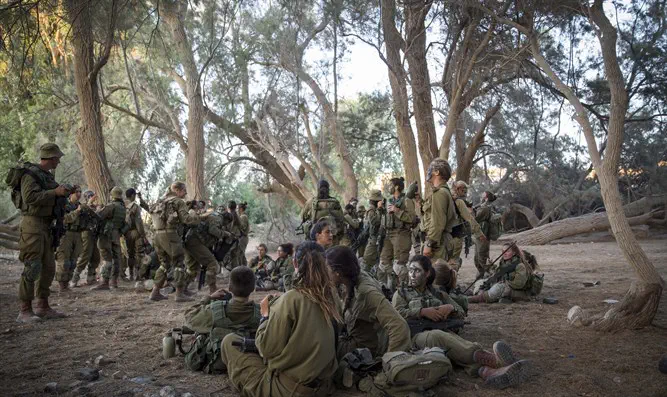by Shlomo Pyotrovsky
New report by Liba Center suggests IDF may be ignoring - and concealing - dangers to female recruits to combat units.

Mixed-gender Caracal battalion
Flash90
While the IDF’s public relations division has made much of Israel’s progressive approach to gender in the armed forces, a new report suggests the army may be ignoring reality that does not conform to the vision it has pursued since the late-1990s.
According to the report, published by the national religious Liba Center, the IDF’s own studies of mixed-gender units reveal a far less optimistic view of female service in combat roles than the image projected by army spokespeople.
The Liba Report, segments of which were obtained by Arutz Sheva, cites internal army studies going back as far as 2000 which show female combat soldiers suffered serious physical injuries at a rate significantly higher than their male peers.
The first such study, conducted from 1999 to 2000, showed that women in combat units suffered serious injuries during training at a rate more than six times higher than men. While just 8% of men suffered such injuries, a full 50% of women did, including many suffering from broken bones.
A later study, also conducted in 2000, assessed the feasibility of integrating women into the elite air rescue unit – the 669. The conclusion of the study clearly stated that female service members were not suited to the physiological stress. Other studies surveyed showed that during times of physical exertion, including in combat situations, female service members are far more likely to suffer irreversible injuries.
In a multi-year study of male and female members of the mixed-gender Caracal battalion, it was revealed that despite having reduced standards as a mixed unit, 12% of the battalion’s female soldiers suffered from stress fractures during their operations in Caracal, while 0% of the male soldiers did.
The study also revealed that male soldiers were adversely affected by the lowered standards of Caracal units, with male Caracal service members having on average lower physical fitness levels than male combat soldiers in non-mixed battalions. In general, female soldiers required a 30% reduction in the standards the IDF imposed on male soldiers for physical abilities.
Despite these and a number of other studies surveyed by the Liba Center report, the IDF has proceeded with expanding the roles open to female combatants rather than reduce them.
Over the past decade, for instance, female soldiers have been increasingly integrated into units across the army as paramedics, and by 2009 a special course for female soldiers was opened, with the ultimate goal of bringing the number of female army paramedics to 50% of the total.
Yet even from the beginning a number of incidents suggested many female paramedics were unable to fulfill their duties in the field. One female paramedic in 2006 serving on Mount Hermon in the Golan Heights along the Syrian border was found to be unable to bear the load required of paramedics.
In another case in the winter of 2008, a female paramedic assigned to the 202nd Paratroopers operating in the Har Dov area along the Lebanese border was found unable to carry the required weight, forcing the platoon doctor to take her place.
Shlomo Pyotrovsky
Source: http://www.israelnationalnews.com/News/News.aspx/220939
Follow Middle East and Terrorism on Twitter
Copyright - Original materials copyright (c) by the authors.
No comments:
Post a Comment